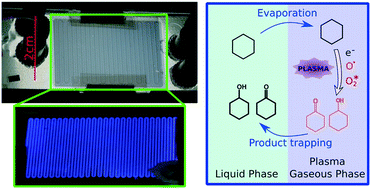当前位置:
X-MOL 学术
›
React. Chem. Eng.
›
论文详情
Our official English website, www.x-mol.net, welcomes your
feedback! (Note: you will need to create a separate account there.)
Microfluidic chips for plasma flow chemistry: application to controlled oxidative processes†
Reaction Chemistry & Engineering ( IF 3.4 ) Pub Date : 2018-10-04 00:00:00 , DOI: 10.1039/c8re00122g Julien Wengler 1, 2, 3, 4, 5 , Stéphanie Ognier 1, 2, 3, 4, 5 , Mengxue Zhang 1, 2, 3, 4, 5 , Etienne Levernier 3, 5, 6, 7, 8 , Cedric Guyon 1, 2, 3, 4, 5 , Cyril Ollivier 3, 5, 6, 7, 8 , Louis Fensterbank 3, 5, 6, 7, 8 , Michael Tatoulian 1, 2, 3, 4, 5
Reaction Chemistry & Engineering ( IF 3.4 ) Pub Date : 2018-10-04 00:00:00 , DOI: 10.1039/c8re00122g Julien Wengler 1, 2, 3, 4, 5 , Stéphanie Ognier 1, 2, 3, 4, 5 , Mengxue Zhang 1, 2, 3, 4, 5 , Etienne Levernier 3, 5, 6, 7, 8 , Cedric Guyon 1, 2, 3, 4, 5 , Cyril Ollivier 3, 5, 6, 7, 8 , Louis Fensterbank 3, 5, 6, 7, 8 , Michael Tatoulian 1, 2, 3, 4, 5
Affiliation

|
The present paper reports the integration of nonthermal plasma into a biphasic gas–liquid microfluidic chip. It evaluates the potential of plasma activation to become a synthetic tool in organic chemistry, operating under mild conditions (room temperature, atmospheric pressure) and without a catalyst. Few preceding works on plasma chemistry involved a liquid phase and none of them was able to handle the high reactivity of plasma to achieve both high conversion rates and selective reactions. We fabricated a glass-polymer microfluidic chip comprising a one metre long serpentine channel, in which a parallel gas–liquid flow was stabilized thanks to a specific step-like cross-sectional shape. Transparent ITO electrodes, deposited on both sides of the chip and linked to an AC high voltage source, produced a dielectric barrier discharge along the channel. We assessed the behaviour of the flow through optical observations and characterized the discharge through electrical measurements and real time intensified-CCD monitoring. We report the successful treatment of liquid cyclohexane with oxygen plasma inside our chip. The GC analysis of the outflowing liquid revealed only a partial oxidation of cyclohexane into a mixture of cyclohexanol and cyclohexanone (industrially known as “KA oil”), and cyclohexyl hydroperoxide, with a total selectivity above 70% and conversion up to 30%. This indicates that alkanes can be activated and functionalized by means of plasma discharges, in a controlled way. In that respect, we claim to have successfully overcome some of the barriers to industrially relevant plasma chemistry. We believe that the combined use of plasma and microfluidic technologies is essential to the development of this new field of research.
中文翻译:

用于等离子流化学的微流控芯片:在受控氧化过程中的应用†
本文报道了将非热等离子体集成到气液双相双流芯片中的过程。它评估了等离子体活化在有机化学中,在温和条件(室温,大气压)下且没有催化剂的情况下成为合成工具的潜力。先前很少有关于等离子体化学的研究涉及液相,而且它们都无法处理等离子体的高反应性以实现高转化率和选择性反应。我们制造了一种玻璃聚合物微流控芯片,该芯片包括一米长的蛇形通道,该通道由于特定的阶梯状横截面形状而稳定了平行的气液流动。透明的ITO电极沉积在芯片的两侧,并与交流高压源相连,沿着通道产生了电介质势垒放电。我们通过光学观察评估了流的行为,并通过电学测量和实时增强CCD监测对流量进行了表征。我们报道了在芯片内部用氧等离子体成功处理液态环己烷的方法。流出液体的GC分析显示,环己烷仅部分氧化为环己醇和环己酮(工业上称为“ KA油”)和环己基氢过氧化物的混合物,总选择性超过70%,转化率高达30%。这表明烷烃可以通过等离子体放电以受控方式活化和官能化。在这方面,我们声称已成功克服了与工业相关的等离子体化学的一些障碍。
更新日期:2018-10-04
中文翻译:

用于等离子流化学的微流控芯片:在受控氧化过程中的应用†
本文报道了将非热等离子体集成到气液双相双流芯片中的过程。它评估了等离子体活化在有机化学中,在温和条件(室温,大气压)下且没有催化剂的情况下成为合成工具的潜力。先前很少有关于等离子体化学的研究涉及液相,而且它们都无法处理等离子体的高反应性以实现高转化率和选择性反应。我们制造了一种玻璃聚合物微流控芯片,该芯片包括一米长的蛇形通道,该通道由于特定的阶梯状横截面形状而稳定了平行的气液流动。透明的ITO电极沉积在芯片的两侧,并与交流高压源相连,沿着通道产生了电介质势垒放电。我们通过光学观察评估了流的行为,并通过电学测量和实时增强CCD监测对流量进行了表征。我们报道了在芯片内部用氧等离子体成功处理液态环己烷的方法。流出液体的GC分析显示,环己烷仅部分氧化为环己醇和环己酮(工业上称为“ KA油”)和环己基氢过氧化物的混合物,总选择性超过70%,转化率高达30%。这表明烷烃可以通过等离子体放电以受控方式活化和官能化。在这方面,我们声称已成功克服了与工业相关的等离子体化学的一些障碍。









































 京公网安备 11010802027423号
京公网安备 11010802027423号